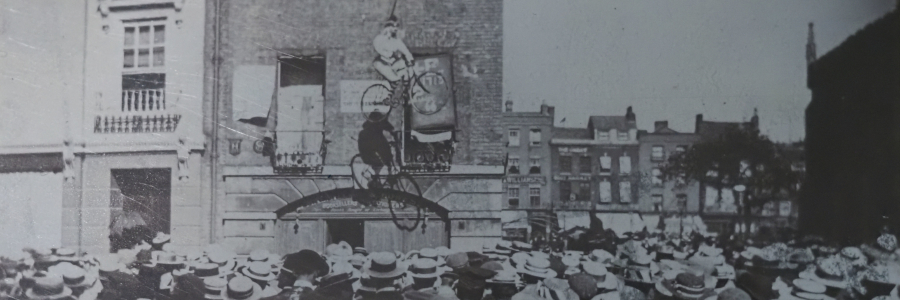
A crowd’s-eye view: the 1897 Cambridge vote for women’s degrees
Sea of straw hats outside the railings. Crackers &c. & then bags of flour, confetti &c. came showering down wind.
Francis Jenkinson, University Librarian
On this day in 1897, the University of Cambridge held a vote on whether to allow women the titles of their degrees. It was the culmination of months (years) of increasingly vitriolic debate. Girton College had been founded in 1869, Newnham in 1871, but the women students were not members of the University, and although they could take the same exams as the men (and outperform them), they were not entitled to their degrees. In the end, the vote went badly against the women and it was not until 1948 that women were finally admitted to full membership of the University.1 A day and night of riotous celebrations by the male undergraduates followed. Shop windows were broken, a giant bonfire was lit in the Market Square and fuelled with pillaged shutters and any other wood that the students could lay their hands on. The damage to public property ran to hundreds of pounds. Francis Jenkinson, watching from the roof of the Library, stood guard over the books, even as a rocket found its way through one of the windows.2
The extraordinary scenes of 21 May 1897 were captured by photographers stationed on rooftops and high places around the Senate House, where the voting took place. Photographs by Messrs Stearn on the Cambridge Digital Library capture the massed crowds and the excitement of the men spilling out of the Senate House after the result was announced. Of all the photographs, surely the most iconic is that of the crowd beneath the notorious effigy of a ‘new woman’ bicyclist in blue bloomers and pink bodice, suspended from a window above the Bowes & Macmillan (now Cambridge University Press) bookshop.3 The effigy was later pulled down and decapitated by the jubilant undergraduates.
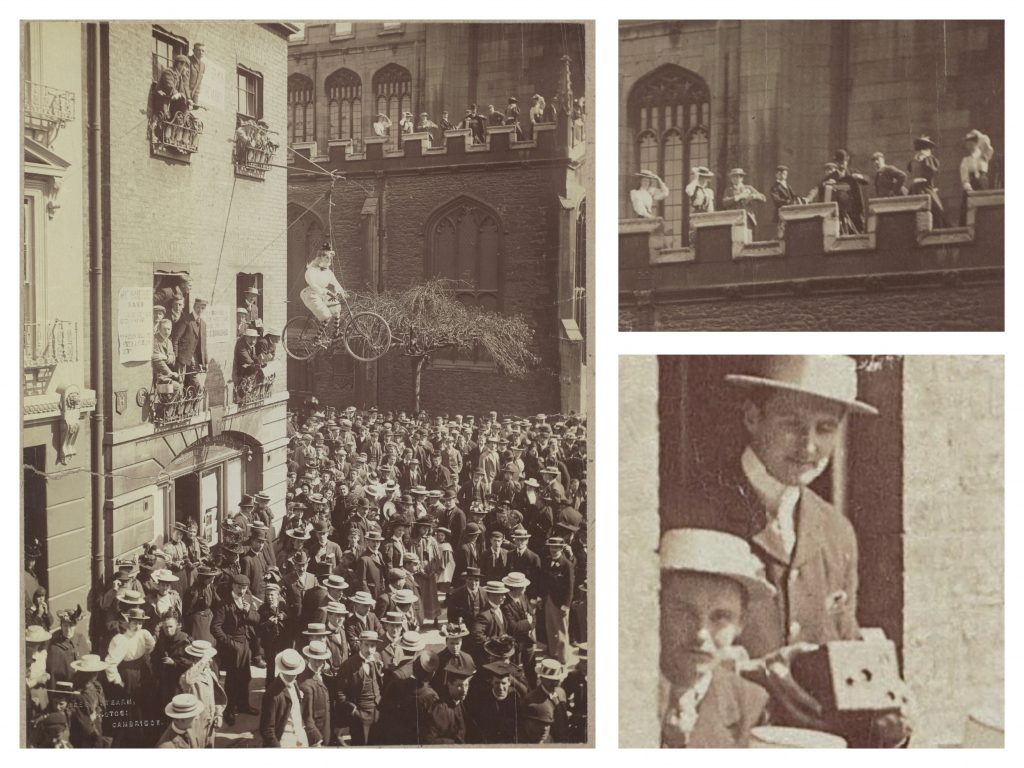
These photograph by Stearn brilliantly capture the spatial politics and literal and metaphorical viewpoints of the day. The Senate House as University space, the mixed crowd outside the railings, every window and rooftop packed with people. There were other photographers on the scene, including large format cameras on the roof of Great St Mary’s and 22 King’s Parade (now Ryder & Amies), and a handheld ‘detective camera’ being used by a man in the window above the effigy of the woman cyclist (I am very grateful to Dr Michael Pritchard for his help identifying this camera as, most likely, a Beck ‘Frena No. 2’).4
The Senate House Yard (and therefore the University Library, which was within the space) had closed to the public at 12:00 noon. Voting was spatially orchestrated (to speed up counting), with those voting against the proposal leaving by one door, and those voting in favour by another. Therefore it would soon have become clear to onlookers exactly which way the day was headed. However, subtle subversions also took place – Francis Jenkinson’s diary records how he viewed the scene from the University Library and whom he took in with him: “Mrs G. Darwin … Mrs Foster, Mrs Clark, Mercy and Mary Hort watched the scene from the East Room: G. D[arwi]n, the children, & I from the roof” (only one of these guests, of course, was a Member of the Senate).
The Stearn photograph is a masterclass in capturing looks and looking. However, a different photograph – a new acquisition for the University Library – gives another view. Taken from the crowd looking up at the effigy of the cyclist, it shows the sea of hats (of men and women). Behind the effigy a crude placard, daubed with paint, displays the results of the vote that were declared at 3:00 pm: ‘N.-Placet 1713 Placet 662’, an almost 3:1 vote against degrees for women.
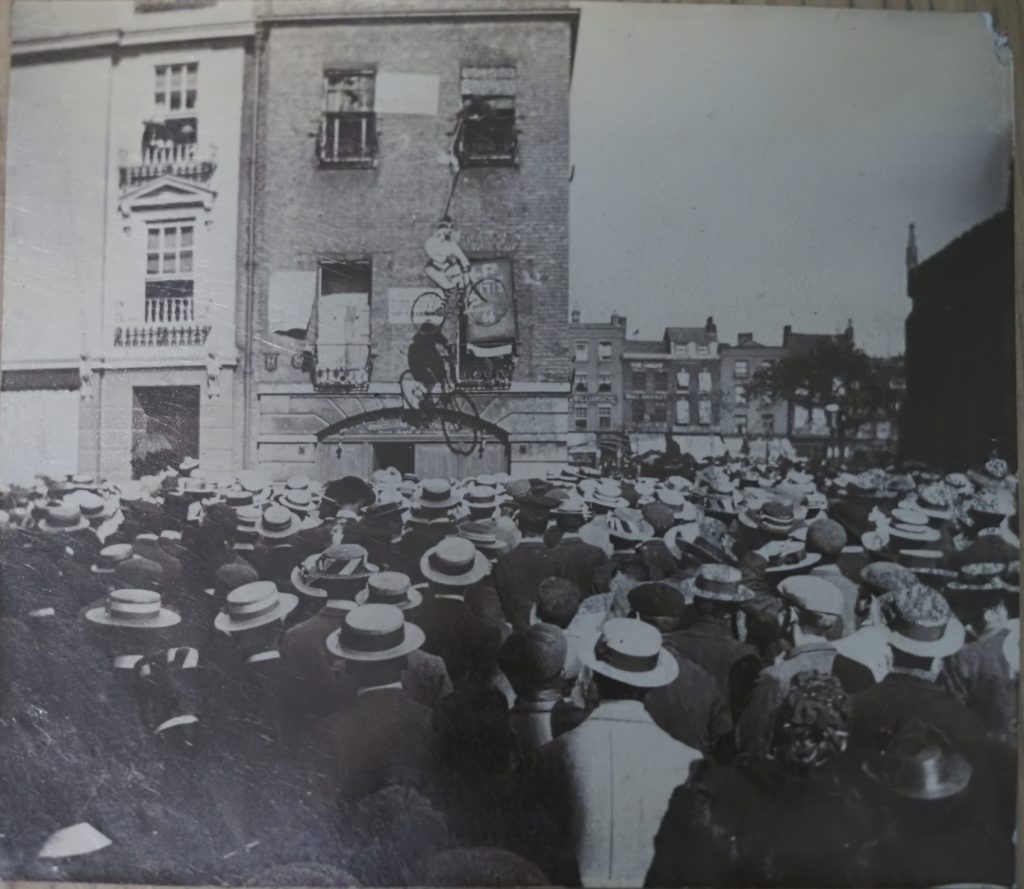
The photograph is small, only 7.5 cm x 8.5 cm, and must have been taken on a handheld camera in the crowd from an elevated position, perhaps similar to the one seen in the window of Macmillan & Bowes. Researching the 1897 vote, I was pleased to discover this very photograph reproduced in The Cambridge Chronicle and University Journal for 14 January 1931, in its ‘Pictures of the Past’ series. The newspaper notes that it ‘was lent to us for reproduction by Mr. H. E. Foster, Shelford Road, Trumpington’. This must be Henry Ernest Foster (1873–1937), son of a college porter and himself a Collector of Poor and General District Rates, who could of course also be the photographer.
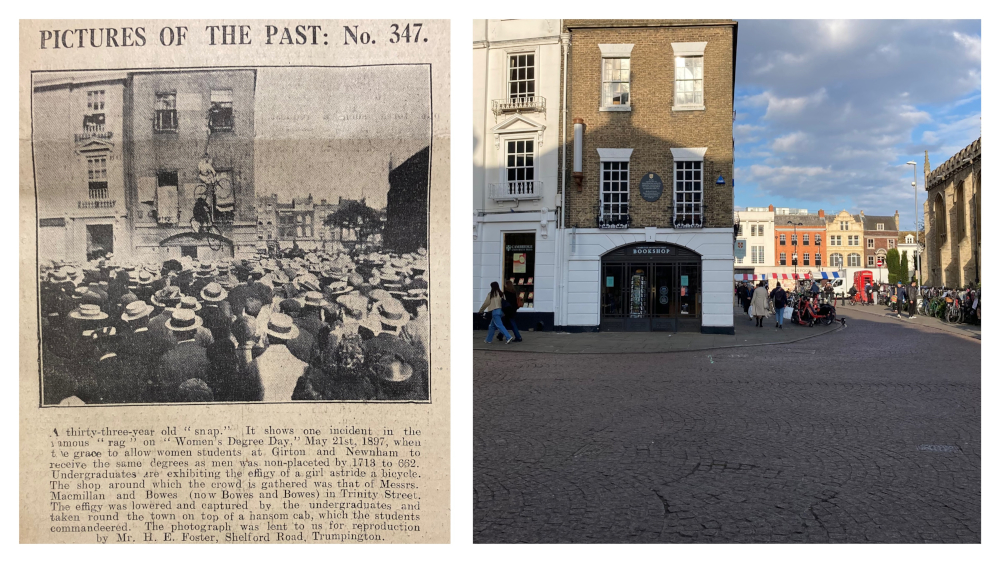
This small photograph is a deeply immersive view in comparison with the large format formal images by Stearn. Several of the windows have been smashed (windows were pelted with fireworks, eggs and oranges). Noticeably, all heads in the crowd are turned towards the effigy, increasing the sense of spectacle – and this is surely the moment before the figure was pulled down:
The lady cyclist came down from the corner of Trinity-street, a piece of the balcony of the house being carried away with it. The figure lost his [sic] head and hands and showed what it was made of. It was rushed away and on the Market-hill appeared on the top of a cab, an excited mob of undergraduates surging below … the cab with the remains of the figure, the bicycle, and the cabby on the top proceeded on a journey round the town, accompanied by horn blowing, wooden rattles, and discordent noises from human throats.5
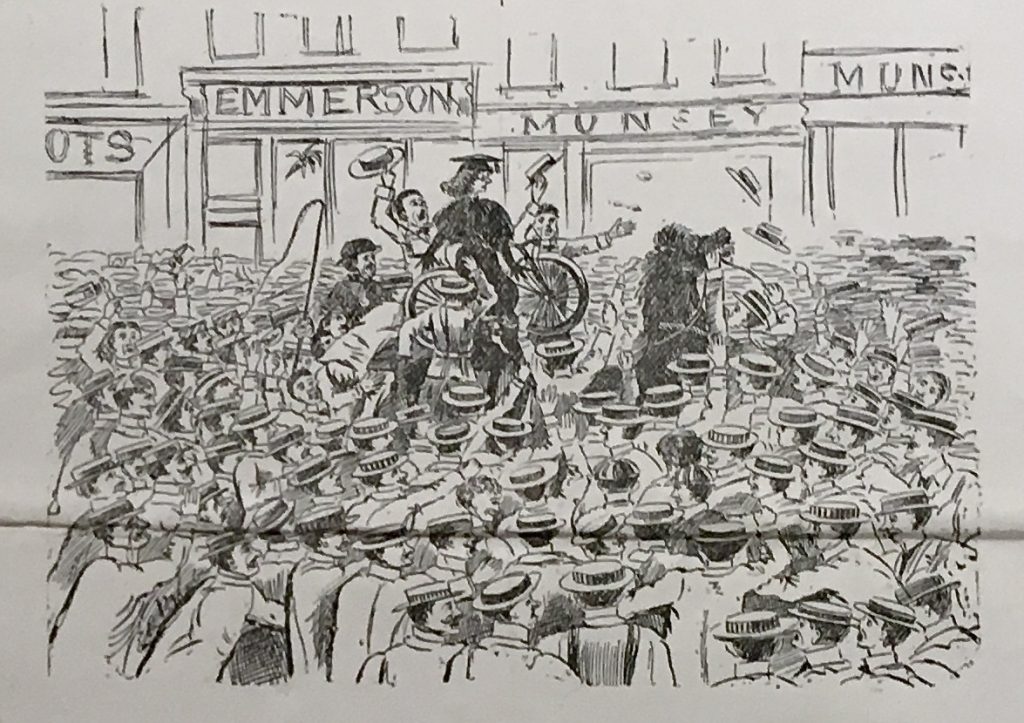
Some of the newspaper accounts say the joyriders took the effigy to Newnham. A caricature of it also appeared in the piece in The Westminster Review and Westminster Budget, which records the trip to the college and the dignified response of the women:
At Newnham, and among those to whom a demonstration of this sort must be particularly painful, seeing that they are giving the best of their lives to the University, the incident was passed over with hardly any remark, and without censure. “After all,” was the only remark, “they are but boys, and (in an undertone) not all are gentlemen.
As a Girton alumna, I’ve been aware of the Stearn photograph of the ‘woman’ on the bicycle for many years, though not at first realising what it meant – it was used for the cover of Muriel Bradbrook’s history of the college, That infidel place, on sale at the Porter’s Lodge. Finding this new photograph has made me look closer. The different photographs inform each other and show different perspectives on the same scene. The small image conveys the intensity of what it must have felt like to be in the crowd as the day turned into a riot; it is a narrow, directed view. The Stearn photograph, a long shot, encourages a general perspective, still with the female effigy at the centre, but also opening up and drawing you into multiple viewpoints and the detail of the onlookers.6 Ultimately, in the Stearn photograph, my eye keeps coming back now not to the cyclist, but to a woman in the crowd, seemingly alone and introspective, not looking around, not looking at the effigy on the bicycle. In the earlier of the two versions, though, she looks straight at the camera. 127 years after the events of 21 May 1897, we can choose to direct our gaze elsewhere instead of aligning it with the photographer of the crowd’s-eye view. This figure of a real woman, not an effigy, is a quietly powerful and very moving portrait in the midst of this momentous Cambridge scene.
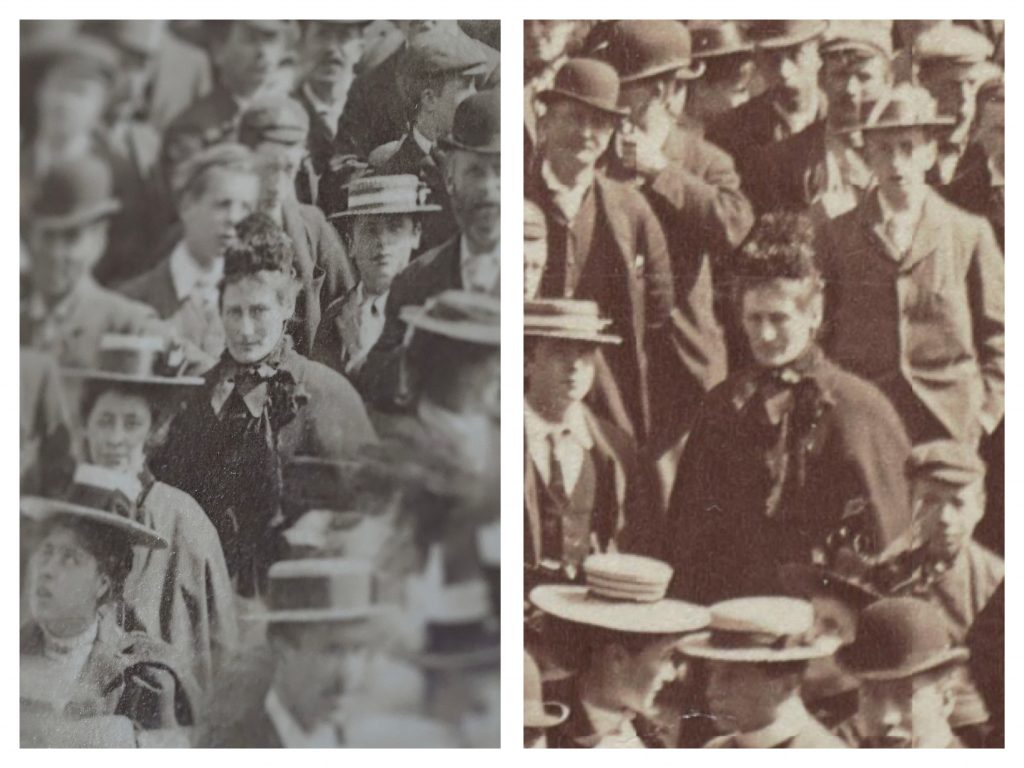
Notes
1. For further details on the background and events of the day, see Ann Kennedy Smith’s excellent blogpost, ‘No women at Cambridge! The 1897 protests. Part One: The men in the photograph’, https://akennedysmith.substack.com/p/no-women-at-cambridge-the-1897-protests.
2. See Jenkinson’s diary entry for the day: Cambridge University Library, MS Add. 7420. ‘The Rising Tide’ collection on Cambridge Digital Library includes images of a rocket and confetti that were thrown by the crowd.
3. At least two versions of this shot were printed. As well as the one on CUDL, there is another, earlier version, a copy of which is included in the album ‘Higher Education of Women 1880–1897’, compiled by University Registrary John Willis Clark, part of the University Archives (UA/CUR 61).
4. The photographer on the roof of Great St Mary’s may have been from the firm Messrs Scott & Wilkinson, St Andrew’s Street, who is reported as being present that day (‘Triumph of man! The ‘Varsity and women’s degrees’, Cambridgeshire Weekly News, extra special edition, 28 May 1897) . None of the photographs on the Cambridge Digital Library taken by Stearn are from that vantage point, though some appear to have been taken from 22 King’s Parade.
5. Cambridge Daily News, 21 May 1897.
6. See Ann Kennedy Smith, ‘No women at Cambridge: the 1897 protests’, Part 2, https://akennedysmith.substack.com/.
